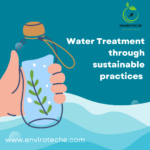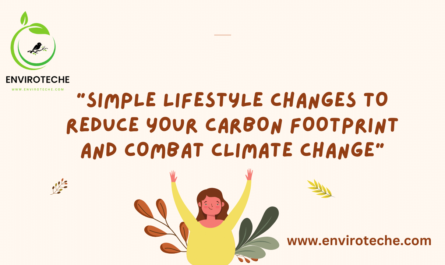
Water is one of the most valuable resources on the planet, sustaining all forms of life. Water contamination, however, has become a big worry as the world’s population and industrialization have grown. Untreated wastewater discharge from industries can have serious consequences for aquatic ecosystems and human health. As a result, wastewater must be treated (green chemistry) before being discharged into natural water bodies.
Chemicals that are harmful to the environment are used in traditional wastewater treatment processes. These substances can harm aquatic life while also posing health hazards to humans. Green chemistry provides an alternative to typical chemical treatments by reducing energy usage and expense while minimizing environmental impact.
What is Green Chemistry?
Green chemistry is a method of creating chemical processes and products that decrease or eliminate the production of harmful compounds while boosting efficiency, cost-effectiveness, and sustainability. Renewable raw materials, non-toxic reagents or solvents, energy-efficient procedures, waste reduction methods, and safer product designs are all part of it.
Paul Anastas and John Warner, two chemists, developed the 12 tenets of green chemistry in 1998. These guidelines offer a foundation for the creation of chemical processes and goods that are sustainable and kind to the environment. Here are the 12 tenets of green chemistry, each individually explained:
1. Prevention: Instead of treating or cleaning up waste after it has been produced, it is preferable to prevent waste formation. This idea motivates scientists to create procedures that reduce or completely stop the production of dangerous chemicals.
2. Atom Economy: Maximizing the inclusion of all components utilized during the process into the finished product should be a goal of synthetic approaches. This idea encourages the effective utilization of raw materials while reducing waste and byproducts.
3. Less Dangerous Chemical Syntheses: Substances with little or no toxicity towards both humans and the environment should be used and generated during chemical transformations. The use of non-toxic or low-toxic reagents and catalysts is advised for chemists.
4. Creating Safer Chemicals: Chemicals should be created with less toxicity for both people and the environment. This idea emphasizes the significance of developing chemicals with negligible effects on ecosystems and human health.
5. Safer Auxiliaries and Solvents: Whenever possible, auxiliary compounds like solvents should be reduced or completely avoided. Greener options with less toxicity and negative ecological effects should be selected when solvents are necessary.
6. Design for Energy Efficiency: Chemical processes should use the least amount of energy possible. Chemists should create procedures that use as little energy as possible, taking into account each step’s energy requirements and looking for ways to cut them.
7. Use of Renewable Feedstocks: To prevent the depletion of non-renewable resources, renewable raw materials, and feedstocks should be used whenever possible. Chemists ought to look into eco-friendly substitutes for products derived from petroleum.
8. Reduce Derivatives: Avoid unneeded derivatization, such as extensive functional group manipulations or protective group constructions. The goal of this idea is to use fewer synthetic steps, less energy, and fewer extra reagents.
9. Catalysis: To avoid using stoichiometric reagents as much as feasible, catalytic reagents should be employed whenever possible. By lowering the number of reagents required, catalysts enable more effective reactions and can be made to be more selective.
11. Real-Time Analysis for Pollution Prevention: To reduce the creation of hazardous compounds, analytical procedures should be created to monitor and control chemical reactions in real-time. Real-time reaction monitoring allows for the optimization of efficiency and the minimization of waste.
12. Inherently Safer Chemistry for Accident Prevention: Materials and procedures should be created to reduce the possibility of mishaps like leaks, fires, and explosions. This idea emphasizes how crucial it is to keep safety in mind while you build and develop chemical processes.
These 12 green chemistry principles provide chemists with guidance for developing ecologically friendly and sustainable chemical processes and products. Chemists can help safeguard human health and the environment by incorporating these values into their work, while also supporting innovation and growth in the field of chemistry.
Green Chemistry in Water Treatment
There has been a growing interest in applying green chemistry principles to water treatment technologies such as coagulation/flocculation, sedimentation/flotation, oxidation/reduction, adsorption/ion exchange, membrane filtration (microfiltration/ultrafiltration/Nano filtration/reverse osmosis), and biological processes such as aerobic/anaerobic treatment.
Coagulation/Flocculation
Coagulation/flocculation is a popular process for removing suspended particles, organic materials, and heavy metals from water. It entails the addition of coagulants (such as aluminium or iron salts) that neutralise the surface charge of colloidal particles, leading them to clump together into bigger flocs that can be removed more easily via sedimentation or filtration.
Natural coagulants, such as chitosan obtained from crustacean shells, are used instead of manufactured compounds in green chemistry approaches to coagulation/flocculation. Chitosan has been demonstrated to remove suspended particles and organic materials from wastewater while remaining non-toxic and biodegradable.
Membrane Filtration
Membrane filtration, which involves eliminating impurities through a semi-permeable membrane barrier, is another extensively used technology in water treatment. Green chemistry methods to membrane filtering include the use of ceramic membranes built from renewable resources such as clay rather than synthetic membranes made from petrochemicals. Ceramic membranes need less energy than polymeric membranes since they do not require backwashing or chemical cleaning after use.
Biological Treatment
Microorganisms are used in biological treatment procedures to breakdown contaminants in wastewater. Aerobic treatments entail providing oxygen to bacteria that degrade organic compounds into carbon dioxide and water, whereas anaerobic treatments use bacteria that degrade organic compounds into methane gas and carbon dioxide in the absence of oxygen.
Green chemistry techniques for biological therapy include optimising bacterial growth conditions by altering temperature, pH, nutrition levels, and so on, lowering the amount of energy consumed throughout the process. Plant-based systems, such as built wetlands, can also help decrease environmental effect while providing wildlife habitat.
Conclusion
Water contamination is a huge global issue that necessitates creative solutions based on long-term principles. Green chemistry provides an alternative to typical chemical treatments by reducing energy usage and expense while minimising environmental impact. The application of green chemistry principles to water treatment technologies can aid in reducing the impact of human activities on aquatic environments and ensuring a sustainable future for everybody. It is critical that we apply these ideas in our daily lives in order to safeguard our most valuable resource, water!
Authors detail:
Muhammad Shoaib Qamar1, Qudrat Ullah1
1Department of Environmental Sciences, Government College University Faisalabad
Check Other Schlorships:

